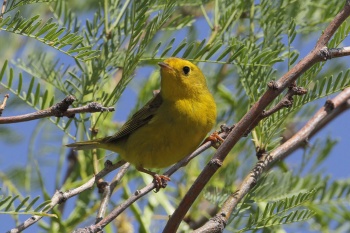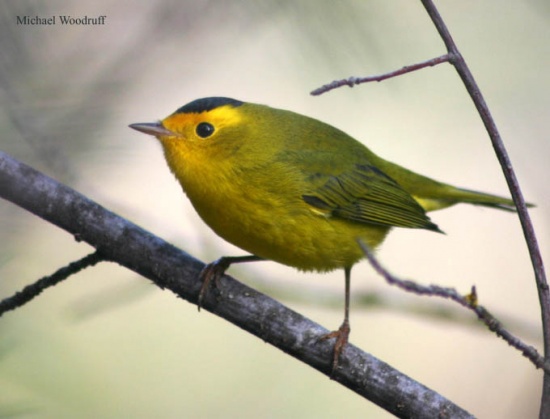- Cardellina pusilla
Wilsonia pusilla
Identification

Photo © by Bob Sheldon
Cottonwood Campground, Big Bend National Park, Texas, USA, 18 April 2016
12 cm (4¾ in)
Male: Face, throat, and underparts yellow with slightly duskier auriculars and glossy black cap. Nape and upperparts yellow-olive, wings and tail darker.
Female: Crown olive to mostly black.
Distribution
Breeds in North America from Alaska throughout most of Canada east to Newfoundland south to northern New York and northern New England in the east; in the west found in coastal mountains south to southern California and in the Rocky Mountain region. In migration found throughout the United States and Canada. Winters Mexico south to western Panama.
Accidental vagrant to Greenland (1 record) and Great Britain (1 record).
Taxonomy
Formerly placed in genus Wilsonia.
Subspecies
There are 3 subspecies1:
- C. p. chryseola - breeds along the pacific coast from British Columbia south to southern California
- C. p. pileolata - breeds from Alaska south to interior west
- C. p. pusilla - breeds from Northwest Territories and Saskatchewan east throughout eastern range
Recent molecular results indicate that these might comprise two species, with C. p. pileolata including chryseola becoming C. pileolata (Pileolated Warbler?)[3][6].
Habitat
Thickets and brush, especially near water. They breed in a variety of woodlands, especially conifererous and mixed deciduous/coniferous and woods on boggy ground.
Behaviour
Diet
Their diet consists mostly of insects and spiders. With the addition of honeydew and berries when available.
Breeding
Their breeding season runs from April to July. Some populations may have a second brood.
Vocalisation
Song: a rapid series of 10-15 short, whistled notes chchchchchchchch with sharp, chattery quality; last few notes usually lower and faster, generally downslurred, sometimes two-syllable.
Listen to a song clip (subspecies C. p. chryseola)
Recording © by Joseph Morlan
Pescadero, California, 02 April 2020
Movements
Medium to long-distance migrant.
References
- Clements, J. F., T. S. Schulenberg, M. J. Iliff, S. M. Billerman, T. A. Fredericks, B. L. Sullivan, and C. L. Wood. 2019. The eBird/Clements Checklist of Birds of the World: v2019. Downloaded from http://www.birds.cornell.edu/clementschecklist/download/
- Dunn, Jon; Garrett, Kimball. 1997. A Field Guide to Warblers of North America. Boston: Houghton Mifflin Company. ISBN 9780395783214
- Birdforum thread discussing taxonomy of this species
- Curson, J. & de Juana, E. (2020). Wilson’s Warbler (Cardellina pusilla). In: del Hoyo, J., Elliott, A., Sargatal, J., Christie, D.A. & de Juana, E. (eds.). Handbook of the Birds of the World Alive. Lynx Edicions, Barcelona. (retrieved from https://www.hbw.com/node/61522 on 11 April 2020).
- Ammon, E. M. and W. M. Gilbert (2020). Wilson's Warbler (Cardellina pusilla), version 1.0. In Birds of the World (P. G. Rodewald, Editor). Cornell Lab of Ornithology, Ithaca, NY, USA. https://doi.org/10.2173/bow.wlswar.01
- Irwin, D.E., Irwin, J.H. & Smith, T.B. (2011) Genetic variation and seasonal migratory connectivity in Wilson’s warblers (Wilsonia pusilla): species-level differences in nuclear DNA between western and eastern populations. Mol. Ecol. 20(15): 3102–3115.
External Links
GSearch checked for 2020 platform.1





